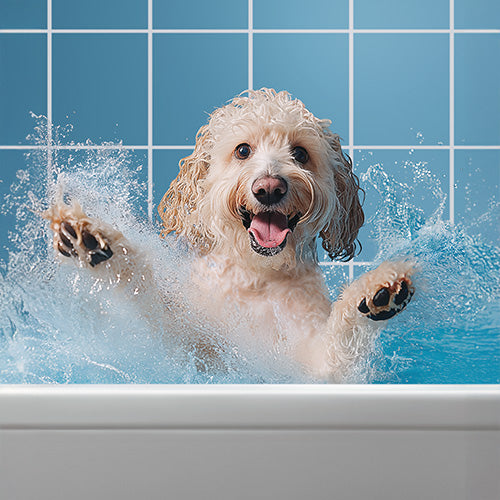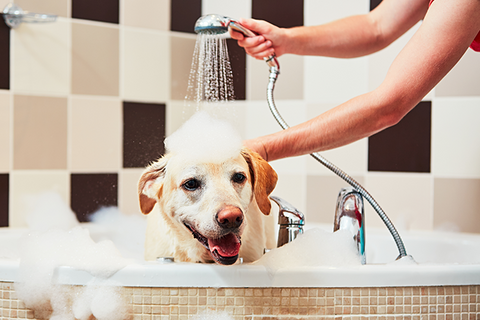
Hot spot alert!
One day, your pet looks perfectly fine and suddenly starts to show discomfort, scratch, and bite itself... you might even say he is in pain! What is happening?
Your pet could be suffering from a “hot spot,” a common yet troublesome skin condition. There can be many different causes of hot spots, and this article will cover them, as well as how to recognise them and treatment options.
Hot spots? Quite a funny name!
‘Hot spot’ lesions re technically called ‘pyotraumatic dermatitis’ or ‘acute moist dermatitis.’ They consist of solitary skin lesions that are inflamed, infected and often moist, oozy and painful. In more severe cases the skin can actually bleed too! Hot spot lesions are more commonly found on the face, head, neck and limbs of dogs. They also appear very quickly, and they can grow in size at an incredibly rapid rate, sometimes going from 0 to 10 cm across in a matter of hours. Therefore, early diagnosis and management is advised to stop the lesion from spreading and becoming too large. Sometimes they present in first opinion practices as genuine emergencies because the condition can progress at such a fast rate and can cause individuals a lot of pain.
How do you spot a hot spot?
Hot spots develop when an area of skin becomes damaged or traumatised and then normal skin bacteria overrun the skin’s natural defence system. In the primary stages, the skin becomes inflamed, infected and starts to become incredibly itchy! The infected debris (pus) then dries and forms a scab or crust on the surface of the hot spot, which then causes your pet to lose their hair over the affected area. Recognising hot spots on the skin is much easier in shorter haired dogs. As well as the characteristic skin lesion as described above, your dog may be constantly scratching the area and may start to display signs of discomfort. In most cases, once your dog has started scratching the area they don’t stop without veterinary intervention - this is due to the release of ‘flare factors’ which makes the skin lesion more inflamed and painful with every itch. Their feline counterparts are lucky, as cats are rarely affected by hot spots in the same way that dogs are.
When and why do hot spots occur?
The most common cause of hot spot development is direct trauma, from your dog directly scratching or chewing the site. Absolutely anything that can cause skin irritation can lead to hot spots! Often dogs which present to veterinary practices with hot spots have underlying allergic skin disease, and hotspots can be a secondary complication of skin allergies. Other causes include insect bites, excessive skin folds/conformational problems, parasites, skin infections, injuries and dense coats. Dog breeds with long, dense undercoats are often predisposed to hot spots because of the increased warmth and moistness of their skin surface, which provides a desirable environment for bacterial growth. Furthermore, hot spots are much more common in the spring and summer seasons compared to the colder winter seasons. This is because the humidity is higher, which again makes the skin barrier more susceptible to bacterial colonisation. If you do suspect that your dog may be starting with a hot spot, contact your veterinarian as early as possible to start treatment.
How do we manage and treat hot spots?
After your vet has taken a clinical history and performed a full clinical examination, they may attempt to clip or shave the fur away surrounding the hot spot. This will allow much better visualisation of the extent of spread, as well as allowing better cleaning of the site and faster healing. Clipping and cleaning of the site also removes a lot of the infected discharge and pus that is usually stuck to the skin. Once a hot spot diagnosis has been made, the management plan is dependent on the severity of the skin condition. In only quite mild cases, your vet may prescribe topical anti-inflammatory treatment to settle down the skin inflammation. At this point, topical antibacterial therapy with a mild skin disinfectant can be critically important. In fact, DOUXO® S3 PYO has been specifically designed for this use, acting as a gentle antibacterial and antifungal agent to reduce the bacterial count.
However, in the more severe cases, your vet may prescribe a course of systemic antibiotics and anti-inflammatories as well, to control the condition at a deeper level of the skin.
How can hot spots be prevented?
Prevention of any condition is always better than cure. If your dog has a dense, thick undercoat, then regular grooming and hygiene can help to prevent skin issues from developing. Also, it is very important to keep up to date all year round with parasitic control. Dogs with fleas become itchy really fast and we know that intense scratching can lead to hot spots! Additionally, if your dog is suspected to have underlying allergies, it is important to continuously manage their condition and itchy levels and your Vet will guide you on this.
There are now many topical sprays available to help to soothe the skin, but you should always check with your veterinarian first before applying anything to your dog’s skin. DOUXO® S3 PYO is a great antiseptic topical product which comes in a variety of forms including shampoo, pads and leave on mousse. DOUXO® S3 PYO disinfects the skin due to the antiseptic action of chlorhexidine. It also has anti yeast properties whilst still keeping the skin surface hydrated. Therefore, this product can be extremely useful in aiding hot spot management.
To conclude, in many individuals, hot spots are preventable depending on the underlying cause. It is important to identify them quickly and seek veterinary support as early as possible before the issue becomes worse. There are different management strategies available depending on the severity of the hot spot.
We recommend DOUXO® S3 PYO
















